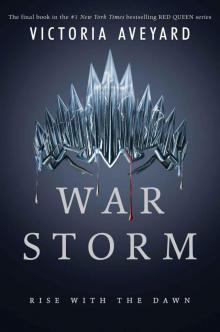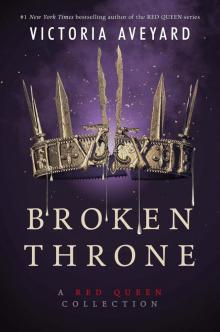- Home
- Victoria Aveyard
Broken Throne
Broken Throne Read online
END PAPER
DEDICATION
I can’t believe you’ve been with me this long. Thank you.
CONTENTS
Cover
End Paper
Title Page
Dedication
Prologue
Jacos Family Tree
Monarchs of House Calore
Queen Song
Steel Scars
World Behind
One
Two
Three
Four
Five
Six
Seven
Iron Heart
One
Two
Three
Four
Five
Six
Fire Light
One
Two
Three
Four
Five
Six
Fare Well
Maven
Cal
Cal
Acknowledgments
About the Author
Books by Victoria Aveyard
Back Ad
Copyright
About the Publisher
Prologue
Throughout my studies in Norta, I always found myself working around the edges of events known only as the Calamities. I have always been fascinated with the histories of our distant past, as well as the lessons therein. Unfortunately, the pre-Silverian time lines have always been riddled with holes and are difficult to verify, as primary sources were largely lost. Only relatively recent events (recent being within the last 1500 years) can be considered set in stone. Despite being already accepted points of record, they are still vital, like the first steps down a pathway.
Therefore, I must base all my research on this relevant time line, correlating with both the archives at Delphie and the vaults of Horn Mountain (note: dates are based on the Nortan calendar; my apologies to the Republic):
• OE = Old Era, before the formation of Norta
• NE = New Era, after the formation of Norta
Before 1500 OE: Civilization across the continent still in state of flux following the Calamities
1500 OE: Beginning of the Reformation Period—civilizations of the continent begin to stabilize and rebuild
950 OE: Trial of Barr Rambler—earliest verifiable record of Silver individuals (a strongarm displays his abilities while being tried for thievery)
~900 OE: Foundation of the Finix Dynasty, formation of the Kingdom of Ciron, the oldest Silver-led kingdom on the continent (according to Cironian lore)
202 OE: Following civil war, the Kingdom of Tiraxes restructures into the present-day triarchy
180 OE: Formation of the Kingdom of Tetonia in what will become present-day Montfort. Tetonia is one of many small kingdoms and lands to sprout up in the mountains
72 OE: Formation of the Kingdom of the Lakelands through the conquests of the Cygnet Line
0 NE: Formation of modern Norta under the dynasty of House Calore—the smaller kingdoms and city-states of the region are forged into one
2 NE: An alliance between Piedmont and Norta is established through marriage, forming the bedrock of a longstanding bond between both nations.
170–195 NE: The Border Wars between the Lakelands and various Prairie warlords
200 NE: The Lakelander War begins between Norta and the Lakelands
296 NE: Dane Davidson, future premier of the Free Republic of Montfort, flees Norta
321 NE: The Nortan Civil War—secession of the Rift, abdication of King Tiberias VII of Norta, fall of the Kingdom of Norta, abdication of King Ptolemus of the Rift, abdication of Queen Evangeline of the Rift, formation of the Nortan States
The above are selected highlights of historical fact, which can be found in most any passable text from Ascendant to Harbor Bay. I’m not terribly interested in what I’ve already learned, and neither are the scholars of Horn Mountain. After weeks of study, to Sara’s chagrin, I’ve attempted to compile some kind of overview of the time before the Reformation. It must be noted, the information is hardly scientific and, at present, impossible to correlate. Much of what I’ve encountered directly contradicts other sources, therefore I have attempted to paint a picture of the overlap.
Most helpful has been a painstakingly preserved collection of paper annuals or pamphlets, kept in a climate-controlled and pressurized room deep in the vaults of Horn Mountain. Records indicate they were stored there before the existence of Montfort, more than a thousand years ago when the vaults were first sealed. I must assume that the vaults, originally built to survive the Calamities, were stocked with information meant to outlive their owners. Several of the documents appear to be of the same set, and feature what were once beautiful photographs. Translation has been difficult, but not impossible. One set was perhaps called Nation’s Geography or the like, while the other is quite simply labeled Time.
* * *
I was also extremely partial to some illustrated books detailing the exploits of a crime-fighting, angst-ridden bat person.
* * *
First, we must work backward from a fixed point in history—this being, for us, the 1500 NE benchmark that begins the Reformation. Everything before and during the Calamities is shrouded in historical fog, with myth often overtaking fact.
We know for certain that the Calamities themselves effectively ended or severely crippled the civilizations that came before our own, so much so that we are still, even now, piecing together a picture of that time.
According to the sources in Horn Mountain, the first of the so-called Calamities—the most destructive and longest lasting—was a catastrophic change in climate due to widespread pollution on a global scale. It worsened over decades, each year worse than the last. Drought rocked much of the world, including lands beyond the oceans bordering our continent, places I have not yet begun to fathom.
* * *
It’s possible those places beyond our continent no longer exist, or are still in reformation periods of their own. For the Silver kingdoms, war and self-interest have kept us restricted to our own backyards, so to speak. Perhaps the same can be said of the rest.
* * *
Drought, in time, led to agricultural collapse, famine, migration, upheaval, and war in the affected areas, with many refugees attempting to flee into the regions still producing food. Resource wars sparked everywhere and often, over water, fuel, land, etc. These were largely seen in clashes between organizations, or between organizations and indigenous peoples. Very few larger governments were directly in conflict in the first years of the resource wars.
The changing climate fed into deadly storm systems, both on land and at sea, driving many people inland from the coasts, where they found themselves facing blizzards, ice storms, tornadoes, and drought-born, long-lasting dust storms. Rapidly changing temperature norms effectively pushed humans to the brink, while leading to the extinction of many plants and animals. Sea-level rise also contributed to the boxing-in effect, forcing populations into smaller and smaller areas of habitation. There was also extreme flooding, which transformed the mouth of the Great River and the surrounding region, submerging hundreds of miles of land to form the coastlines we know today.
In conjunction with flooding, widespread earthquakes changed the western coastline, forming a sea in what was once a massive valley. Long-dormant volcanoes erupted in the northwest, shooting millions of tons of ash into the air.
It is interesting to note that, while multiple earthquakes and natural disasters laid waste to the continent, the most feared cataclysm never came to pass. According to the preserved texts, scientists and civilians alike were incredibly concerned by the possible eruption of the caldera volcano beneath what is now the Paradise Valley. Said e
ruption would have changed the world climate and destroyed most of the continent we now live on. At the time of the preserved texts, scientists postulated that the caldera basin was long overdue for eruption. By now, we are far beyond that. I will be petitioning the Premier and the People’s Assembly to organize an analytical team to keep tabs on the Paradise Valley and the sleeping giant beneath it.
It’s no surprise that, in the midst of such turmoil, disease sprang up in many regions, spreading outward even into “safe” groups. Many diseases were mutated versions of less-threatening illnesses or previously eradicated diseases finding new purchase in once-protected populations. Millions the world over succumbed to illnesses that had once been considered curable, and most civilizations began to fall apart.
All these, of course, were actions of nature or, some might argue, actions of the gods. Not so for the last of the Calamities, an act of choice and an act of men. We have military might today, bombs and missiles of varying size and quality, but nothing to compare to the monstrous weapons our ancestors created. Somehow, by splitting the tiniest pieces of existence, scientists of the old world discovered they could make the most destructive of weapons, called nuclear bombs. These were, throughout the various disasters above, used across the known world to varying degrees of destruction. Even before the advent of nuclear war, governments and citizens feared these weapons. Many planned accordingly. The vaults at Horn Mountain were themselves designed to survive such an attack, carved deep into the rock. According to the texts there, our own continent was largely spared the worst of these weapons. There are lands across the ocean that no longer exist, now either frozen over or sand swept, flattened by the wrath of a few and the ignorance of many. Far worse than the bombs themselves was, apparently, the aftermath. Radiation disease spread with the smoke and ash. Entire countries were destroyed, civilizations collapsing. Such is the case on our own continent, as demonstrated by the ruins of the Wash and the Cog. These lands are still too irradiated to reinhabit, poisoned by deeds thousands of years ago.
* * *
Despite what my research tells me, I find the vast destruction achieved by military technology to be inconceivable, and will do more to corroborate these findings. It simply cannot be possible. Even the strongest of Silvers cannot level a city, and even our bombs cannot cross an ocean to incinerate tens of thousands of people. Perhaps this is my own ignorance, but I cannot fathom the death of millions by the order of one.
* * *
There are few fixed markers of time during the Calamities, especially with long-lasting events such as climate change, which is still largely in play with our own world.
The scientists of Montfort have been attempting ice digs that I don’t entirely understand, but their work in the north is reportedly invaluable to the time line before the Reformation and even during the Calamities themselves. I will record what I can of their findings when they become available, but so far, early reports seem to indicate that radiated ashfall landed in the far north sometime around two thousand years ago. This places at least one act of nuclear warfare (ANW) at approximately 2000 OE, five hundred years before the Reformation. We can then ascertain that true collapse, at least on our continent, lasted half a millennium before civilizations began re-forming.
Connecting the Reformation and the ANW to a pre-Silverian, pre-Calamities time line proves tricky, and again we must look for points of crossover. There are several mentions of catastrophic drought in the preserved texts utilizing the date 2015 CE (sometimes recorded as AD; could be an error in translation—must verify) onward. Other Calamitous events, such as earthquakes, sea-level rise, hurricanes, and the like are mentioned throughout fifty to sixty years’ worth of the preserved texts, but rapidly grow in size and scope toward the end of the collection. They are, however, small in comparison to the earthquake that split the western coast and the flood that re-formed the Great River Delta.
Again, translation can be unreliable. Some texts vary in quality of preservation, and to my surprise and chagrin, many seem to disagree on the severity or magnitude of events, particularly those regarding climate. While one record might consider a warm winter to be the harbinger of a catastrophic climate shift, another downplays the same period of time or highlights a colder winter elsewhere. This pattern is very troubling, though I assume most consumers of these documents were able to identify the bias, as well as the lies or manipulations being presented.
I have managed to find mention of a small nuclear attack dated to the year 2022 CE. I could not discern the combatants involved, only that the attack occurred on a different continent, far from large population centers, in a cold climate. This leads me to think it was a show of strength rather than an act of war, if something so foolish can be believed. However, it does mean, when taken in conjunction with the radiated-ashfall dating, that at the very least the year 2000 OE in our calendar may have been the equivalent of the year 2022 CE in the pre-Calamities calendar. But, if pressed, I would assume that some time separates the two, perhaps a decade or even a century. The research is slow going, but I very much feel that these steps are in the right direction, and the information I’m able to find will be vital to our future.
If anything were to happen to the vaults of Horn Mountain, our own civilization would lose any link to the past and what warnings it left us. Therefore, I will be spearheading an effort to translate, to the best of our ability, as much of the later volumes of the preserved texts as possible. If nothing else, world leaders should know what befell our ancestors, so they can avoid such disaster in the future. I am particularly concerned by man-made climate change, an easy trap to fall into, especially for advancing societies. I speculate that it has already begun in pieces, but I’m hopeful that our nations can avoid what our ancestors did not.
I have included a translation on the next page, albeit incomplete. It paints a stark picture of the sword hanging over all of us.
New studies
This is an integral piece of the puzzle we must finish if we can hope to understand the world that came before ours, and how we came to exist in the world now.
* * *
I am simply one curious man, but perhaps I can take at least a step forward into the fog surrounding us, so that others might follow. You have some of your mother in you, Cal, enough to delight in the knowledge of how things work. Hopefully these copies of my studies are of some interest to you. Hopefully you’ll join me in clearing the fog.
—Uncle Julian
* * *
I’m aware you’re well versed in the history of your house, having taught you some of it myself. But I thought you’d like to keep these for your own, instead of relying on the survival of the Nortan libraries, as well as your own flawed memory. Yes, I said flawed. I apologize that the record of my own house and your mother’s family is not so extensive, but I was regrettably uninterested in my heritage in my youth. And my bloodline is not so well documented as a line of kings for some reason. So strange. —Uncle Julian
Jacos Family Tree
Monarchs of House Calore
* * *
The history books haven’t quite caught up to you, though I doubt you mind.
—JJ
* * *
CAESAR I
JANUARY 1, 0–OCTOBER 3, 37 NE
So dedicated to his new dynasty, nation, and image was Alexandrus Caesar Calore that he waited a full two months after conquering Norta to coronate himself at the stroke of midnight on the turn of the year. He declared a new age with the beginning of his reign. Therefore, the Nor
tan calendar starts at the exact moment the crown touched a Calore’s head. Though a warrior first, King Caesar was a skilled diplomat. He married his daughter Juliana to the High Prince of Piedmont, cementing a long-standing alliance to protect Norta’s southern border. King Caesar also created the rite of Queenstrial. Except under extraordinary circumstances or when marrying outside the kingdom, any Calore heir to the throne would wed the strongest suitor who presented him- or herself. King Caesar also founded the new capital at Archeon, building Whitefire Palace and the Nortan seat of government. The king died in a dueling “accident,” struck through the heart. The blunted training sword of his opponent had been replaced with a sharpened blade. Legend says the last word King Caesar ever spoke was “Fyrias,” the name of his youngest son, who had died in a skirmish along the border of the Disputed Lands. Following an investigation, his dueling partner was executed, but historians postulate that Caesar’s own son arranged his father’s murder.
CAESARION
OCTOBER 3, 37–JULY 20, 44 NE
Filling the footsteps of a great father proved difficult for Caesarion, who grew up with little knowledge of war and less military skill than his father. He was more preoccupied with the luxuries of the monarchy, and began building the summer palace: the Hall of the Sun. Before its completion, he died at sea when his pleasure yacht sank off the Bahrn Islands. Witnesses say the king drowned due to the weight of his jewels and crown, though there are reports of sharks feeding on him as well. It’s possible the sinking of his ship was orchestrated by those loyal to his father, the murdered king.
JULIAS I
JULY 20, 44–AUGUST 1, 60 NE

 Red Queen Novella #2
Red Queen Novella #2 Red Queen Novella #1
Red Queen Novella #1 Red Queen
Red Queen War Storm
War Storm Glass Sword
Glass Sword King's Cage
King's Cage Broken Throne
Broken Throne